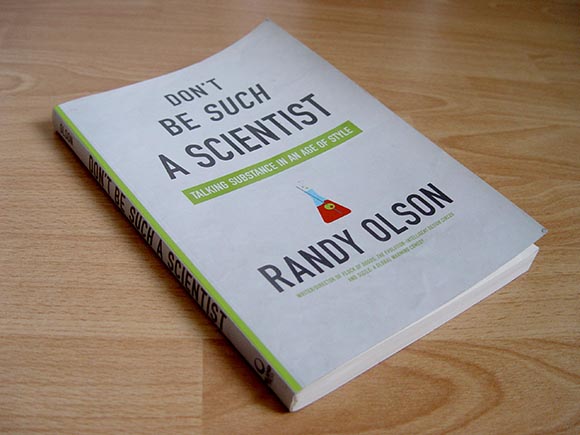Speaking of books I have read recently. There is another one I haven’t written about yet. It’s called Don’t Be Such a Scientist.
It’s written by Randy Olson, a marine biologist, who turned into a movie director at some point. I heard about the book (again) on the Scepticality podcast and I was intrigued. The book is tries to highlight the mistakes many scientist and writers make when they communicate scientific facts to a broader audience. The reason why I found that interesting is because I wad playing with the idea of developing a Sci-Fi game that sticks to scientific fact rather than drifting off into the realm of leprechauns and unicorns. However, I’m concerned with falling into some common pitfalls. I have the impression that there are many Serious Games projects, where the designers focus so much on hammering a certain message home, that they forget to put the fun in. So I was expecting some practical advice on how to structure and develop a piece of work that contains science but manages to emotionalize it.
Unfortunately, I was kinda disappointed. Yes, Randy has collected some nice tips and he included a lot of humorous examples. However, the advice is very broad and abstract. The examples on the other hand are quite specific and it’s difficult to distill from them practical lessons. The chapters have captions like “Don’t Be So Literal Mided” or “Don’t Be So Unlikeable”. Granted, he does elaborate a little bit but it doesn’t really come together into a unified strategy.
And you know something isn’t quite right when you start reading things you straight out disagree with. In a very early chapter, he presents a model in which an audience has 4 organs that can be stimulated with a piece of work: the head, the heart, the gut and (basically) the dick. Over and over again he comes back to that model explaining that it’s easier to reach a wide audience the further you go down that list. I found that model quite simplistic and not really useful. Of course sex gets you a lot of eyeballs. But what good does it do you when you are basically tricking people to watch your stuff by injecting sexual content into it? Maybe you should have invested that extra effort to make your content inherently more interesting and valuable. Also what exactly is the difference between the heart and the gut? It’s never really explained.
Another thing that I disliked was that a lot of the examples from the book are taken from the couple of movies he did. Especially, he mentions Sizzle and Flock of Dodos quite a lot. For somebody who never watched the movies, the examples aren’t that helpful. It’s not like he uses his insider knowledge to take the movies apart and explain the process behind the scenes in detail. They remain superficial references.
Finally, even the sub-title is something I would argue with: “Talking Substance in an Age of Style”. It’s the tired, old false dichotomy of form vs. content. A model that is simply a mental dead-end when you are developing a piece of work with any sort of ambition. Excellence in communication and pretty much any design discipline comes from not being able to distinguish form from content anymore.
That doesn’t mean that everything in the book is wrong. The advice is certainly useful for scientists, who never thought about how to communicate their work properly. However, as a Game Designer, I need something more in-depth and specific.
I was wondering, do you guys know games / serious games that try to teach or simulate something but forget to evoke enthusiasm for their subject? Maybe we can get a discussion started to sort out common problems.






